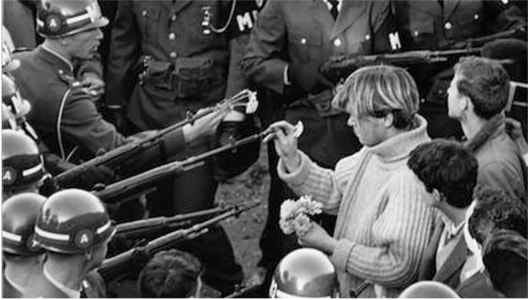The Movement that Ended the Vietnam War |
To download a pdf of this article, click here.
|

by Jim Tarbell
The peace generation that ended the Vietnam War grew up amidst the glorification of World War II, with toy machine gunners and flame throwers.
They came of age as millions of people, in what was known as the Third World, celebrated independence and freedom from imperial colonization. Back in the US, however, American foreign policy came under the secretive shadow of the national security state and its covert action arm, the Central Intelligence Agency. Staffed by offspring of the economic elite, the CIA worked anonymously to subvert the freedom and independence of the newly freed colonies in order to insure America's wealth and corporate access to resources and markets around the world.
The youth of the United States were not deceived. As the CIA conflict in Vietnam escalated into a full scale war, drafting young Americans as military fodder, the peace generation became the adults in the room by creating a peace movement proclaiming “love not war.” They bravely faced down the initial militarization of the police.
When the US Air Force began bombing North Vietnam and President Lyndon Johnson sent in the first contingent of Marines in early 1965, 80% of Americans were in favor of the effort.
In response, that Spring Students for a Democratic Society (SDS) brought 15,000 people opposing the mushrooming war effort to DC. In June, 17,000 people joined a peace rally in New York's Madison Square Gardens where Dr. Benjamin Spock, the doctor who nurtured the peace generation, spoke. He encouraged the crowd to stop this US war that denied the people of Vietnam their independence. By August of 1965, support for the war had decreased by 25%.
In March of 1966, peace parades and rallies exploded across the country from Boston to San Francisco. By January of 1967, only 52% favored war in Vietnam.
In October 1967, 50,000 citizens, concerned about the violence and death of the US war, occupied all the area around the Pentagon. By February 1968, only 42% of Americans supported the War.
In October 1968, a series of pro-peace events in Detroit, Miami, Boston and New York involved hundreds of thousands of people. A month later, the largest political demonstration in history drew 500,000 participants of all ages to parade down
Pennsylvania Avenue singing, “Give Peace a chance.”
By January 1970, only 32% of those polled favored US policy in Vietnam. In May, peace marches swept the country after National Guardsmen shot peaceful students at Kent State University in Ohio.
Six months earlier, the US had begun withdrawing troops from Vietnam. The last US troops left by the end of March 1973. The US military did not invade another country for ten years, and did not engage in a sustained ground war for almost two decades, bringing a peace that lasted for a generation.
The peace generation that ended the Vietnam War grew up amidst the glorification of World War II, with toy machine gunners and flame throwers.
They came of age as millions of people, in what was known as the Third World, celebrated independence and freedom from imperial colonization. Back in the US, however, American foreign policy came under the secretive shadow of the national security state and its covert action arm, the Central Intelligence Agency. Staffed by offspring of the economic elite, the CIA worked anonymously to subvert the freedom and independence of the newly freed colonies in order to insure America's wealth and corporate access to resources and markets around the world.
The youth of the United States were not deceived. As the CIA conflict in Vietnam escalated into a full scale war, drafting young Americans as military fodder, the peace generation became the adults in the room by creating a peace movement proclaiming “love not war.” They bravely faced down the initial militarization of the police.
When the US Air Force began bombing North Vietnam and President Lyndon Johnson sent in the first contingent of Marines in early 1965, 80% of Americans were in favor of the effort.
In response, that Spring Students for a Democratic Society (SDS) brought 15,000 people opposing the mushrooming war effort to DC. In June, 17,000 people joined a peace rally in New York's Madison Square Gardens where Dr. Benjamin Spock, the doctor who nurtured the peace generation, spoke. He encouraged the crowd to stop this US war that denied the people of Vietnam their independence. By August of 1965, support for the war had decreased by 25%.
In March of 1966, peace parades and rallies exploded across the country from Boston to San Francisco. By January of 1967, only 52% favored war in Vietnam.
In October 1967, 50,000 citizens, concerned about the violence and death of the US war, occupied all the area around the Pentagon. By February 1968, only 42% of Americans supported the War.
In October 1968, a series of pro-peace events in Detroit, Miami, Boston and New York involved hundreds of thousands of people. A month later, the largest political demonstration in history drew 500,000 participants of all ages to parade down
Pennsylvania Avenue singing, “Give Peace a chance.”
By January 1970, only 32% of those polled favored US policy in Vietnam. In May, peace marches swept the country after National Guardsmen shot peaceful students at Kent State University in Ohio.
Six months earlier, the US had begun withdrawing troops from Vietnam. The last US troops left by the end of March 1973. The US military did not invade another country for ten years, and did not engage in a sustained ground war for almost two decades, bringing a peace that lasted for a generation.

